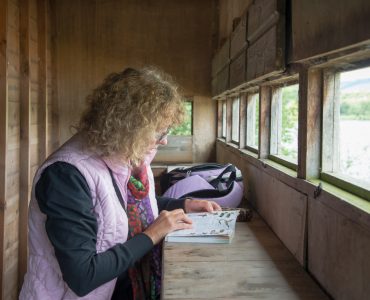The Garden Warbler is a common warbler. It is found to breed in the areas of northern Europe to Western Asia. The bird is classified as a passerine bird which is quite a migratory bird and settles in central and southern Africa during winter. Passerine birds are also known as perching birds. The name passerine is derived from ‘passer domesticus’, the scientific name of the house sparrow and from the Latin name passer for true sparrows and smaller birds. This is a bird which is 13 to 14.5 centimetres long with a brown grey colour on the above and white colour below. The wing span of this bird is around 20 to 22 centimetres and carries a weight ranging from 16-23 grams and consists of 200,000 breeding pairs. It is a stocky bird which has thick grey bill and grey legs while the plumage of this bird is olive brown grey in colour and paler on the underneath. These birds do have a faint hint of supercilium but have no eye strips. The young ones are quite similar to the adults but their colours differ from grey to olive colour. These birds sulk in shrubs and undergrowth and may not be able to identify its presence without hearing its song. These birds can be confused with Common whitethroats and Lesser Whitethroats. These birds have a quite beautiful voice which is quite similar to the Blackcap bird but is quite longer, mellower, less varied and tiresome. They have a well concealed perch and this makes it quite impossible to identify the bird. These birds eat on caterpillars, larvae, spiders, flies and worms and during winter they feed on berries and fruits. These birds breed on woods and large gardens of tall trees, shrubby undergrowth or hedgerows. The nests of these birds are built by both birds and are usually found lower in a tree or bush. The nests of these birds are made from dry grasses and are lined by finer grasses and hair. The egg colour of these birds is white which has a purplish-brown or grey spots on it which is in the range of 20 millimetres by 15 millimetres. The incubating of the egg is done by both the male and female partners and these birds also share their duty of feeding the young ones. The breeding of these birds starts from late May and have 1 to 2 clutches. During the breeding period of these birds, 3 to 7 eggs are laid and the incubation period varies from 10 to 12 days and the fledge days range from 9 to 12 days. These birds are found in Britain during the summer season especially during the months of April to September and they exist in the savannah of Africa in the south of Sahara. The numbers of these birds have fluctuated as other warblers and they sometimes migrate across the Sahara which maybe probably due to a change in the weather conditions prevailing over Africa. Despite the different colour pattern been existing between the Black Cap and the Garden Warbler these two species are closely seen to be related to each other.
Garden Warbler
Let us know if you liked the post. That’s the only way we can improve.








